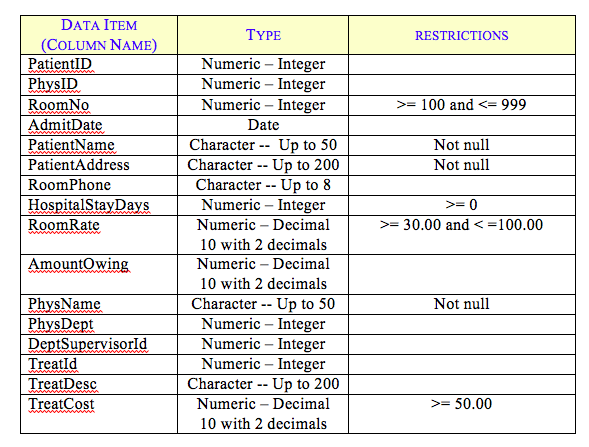Question
Fundamentals of Database Systems Consider the following ERD Where - PatientId: It is the identification number of each patient - PatientName: It is the name
Fundamentals of Database Systems
Consider the following ERD

Where
- PatientId: It is the identification number of each patient
- PatientName: It is the name of the patient
- Patientddr: It is the address of the patient
- AdmitDate: It is the date when the patient is admitted to the hospital
- AmounOwing: The amount the patient owes based on his/her sickness after being discharged
- RoomNo: it is the room where the patient is kept in the hospital
- RoomPhone: The phone number in the patients room
- HospitalStayDays: Number of days the patient would be in the hospital for treatment.
- RoomRate: The rate charged for every day the patient is in the room
In the second table:
- PhysId: It is the identification number of each physician
- PhyName: It is the name of each physician
- PhysDept: It is the department id where physician works
- DeptSupervisorId: It is the id of the physician who is in change of managing the PhyDept. For example, suppose physician x works in department y. DeptSupervisorId is the id of the physician (not necessarily physician x) who in managing department y.
- TreatId is a number that represents the type of treatment the physician can do
- TreatDesc and TreatCost are Treatment description and treatment cost
Each patient is assigned one doctor, but a doctor can have many patients;
There may be more than one patient in a room but each patient is kept in one room only;
Each patient is being treated for one sickness only;
There is only one phone number in each room in the hospital;
Each doctor can do only do one treatment, but a treatment can be done by many doctors;
The treatment cost is fixed for each treatment;
Each doctor works in only one department, but a department can have many doctors;
Each department has 1 supervisor. This supervisor is just one of the physicians who works in that department;
A Patient is charged based on the treatment cost and number of days in hospital;
Note that not all the rooms in the hospital has patient at a particular time but all patient must be is some rooms. Further, only some of the physicians are supervising the departments in the hospital; however, all departments must be managed by some physicians.
You may make any other assumption you think is necessary but you have to be very specific and realistic. You can add other assumptions but you are not allowed to change the above assumptions
Do the following
a) Change the ERD to tables
b) Place the tables in 3rd normal form (if necessary)
c) Revise the given ERD based on the normalized tables (if necessary)
d) Write a script to create a database. Your script should create the tables and ensures that all constraints are set properly.
Here is some information to create your tables using SQL. Depending on your normalization process, some of the following fields may not be in your final normalized table.

DeptSupervisorld PhysID TreatCost PhyName TreatDesc PhysDeptPhysicianTreatd cures PatientHospitalStaydays PatientID PatientName PatientAddress AdminDate RoomPhone RoomNo RoomRate Amount Owing
Step by Step Solution
There are 3 Steps involved in it
Step: 1

Get Instant Access to Expert-Tailored Solutions
See step-by-step solutions with expert insights and AI powered tools for academic success
Step: 2

Step: 3

Ace Your Homework with AI
Get the answers you need in no time with our AI-driven, step-by-step assistance
Get Started


